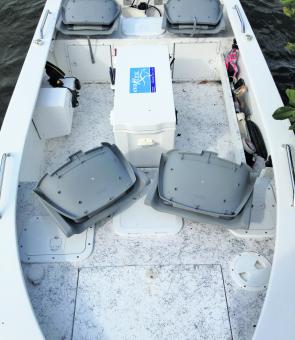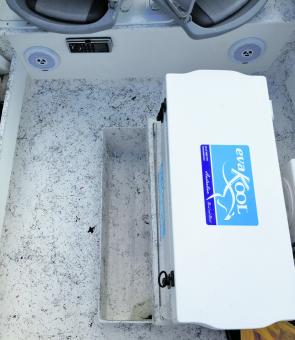The chalk outline I drew on the floor of the shed was pinky-red, the colour of blood. Anyone walking into the shed would have thought a boat had been murdered here and the hull taken off to the morgue.
The opposite was hopefully going to be true. We were witnessing the birth of a vessel: one that would transport cold beer out, and backload cold fish home. A self-sufficient business, I tell my wife. I say it quickly and walk away.
It was a freehand chalk line, 4.3m long by 1.95m wide. The designers at CrossXCountry Boats would be envious of the technology. I’ve got a million different ideas jostling for position.
My list of inclusions was long and broad. The boat had to do a lot of things, therefore the list included a plumbed castnet tray, underfloor fuel tank, esky, live bait tank, side pockets, rod storage, dry storage, console, 4 seats, safety gear, stereo, VHF radio, oars, aerial, rubbish area, yabby bucket, drink holders and rod holders.
Each to his own, but cold beer and fish are my priorities so I started with the esky and worked outwards. I wanted the esky in the middle of the boat, giving everyone access to it wherever they were fishing. Everyone needed to be able to rest their feet on it, make their lunch on it, rest tackle trays, fillet fish on it and get their drinks out of it.
I wanted it tall and long and a minimum of 70L. It needed to be as narrow as possible so the crew could walk around it, and the starboard side will have some sort of console for a sounder, radio and more. To port there will be a side pocket for everyday stuff. The esky had to be just right to fit in with all these needs and design requirements.
Evakool make an 85L fibreglass box 440mm wide x 445mm high x 945mm long. It was perfect – well, nearly.
For use as a table it could have been higher in relation to seat height. So how do you solve this problem?
We discussed this at length with fishing mates, the team at CrossXCountry and anyone who wanted to listen and we decided that we’d build it up by making a storage box in the esky’s footprint about 100mm above the floor. This storage box would go right down to the hull and be a perfect space for safety gear and other out-of-the-way essentials.
We put a 60mm lip around the border and the esky would fit snugly into it, not allowing movement during travel. A bit of lateral thinking and some impressive design by CrossXCountry had everything in place in regard to the Evakool
Leaving 700mm between esky and seats gives enough room to walk around and not too much of a reach to the ‘operating table’.
Underneath the stern seats I’m putting two, 5-tray tackle drawers. They get rid of clutter on the deck so if we’re fishing together, you can put a few trays under your seat and your pliers, leader, lip grips and more can go in a pocket near you.
Yacht winch-handle holders make great pliers /knife storage. Then there’s room for dry storage between the seats and the under-seat tackle boxes.
Behind the aft seats there’s room for three boxes: one for dry storage, one for rubbish/yabbies and one for live bait. The live-bait tank ended up being quite big, so I put a rotating elbow on the drain to allow me to have not much water for small live bait with the elbow down, or rotate it up for more water for bigger fish.
Half the boat done and it already feels like I’ve stressed out everyone I know with design questions.
Maybe it’s pedantic to have a spot for everything but it drives me nuts to have to reach too far for anything, let alone the constant searching through clutter. Comfort is king in my boat and I have customised two boats in the past and have done very well selling them both.
Up forward, 2 seats with a dry hatch/box between them were placed for passengers. A sealed battery box with its own hatch on the port side under the port passenger seat allowed for really good weight distribution and it keeps the battery away from the stern and the sump area.
The 60L stainless fuel tank fit nicely sideways next to the battery box. Note to self: use clear hose as fuel line so I can see when fuel is starting to back up, eliminating blowback. I also wanted a tank with a mechanical gauge so I can see it through an inspection hatch.
I did toy with the idea of running jerry cans in the back but because the hull is so light, I am so ‘muscular’ and the motor and CMC jacking plate weigh 115kg, some weight up the bow was necessary.
The castnet tray is something everyone who chases prawns or uses live bait should have. This is a bloody ripper. A mate was sick of all the mud that came into the boat when throwing a net from the bow so he made a plumbed castnet tray on his boat’s casting platform and plumbed the drain.
It has a lid that sits flush and attaches to the platform when it’s not in use. Just hose it out at day’s end and when not in use, the tray makes great storage for a castnet and a barbecue plate. If you put your net elsewhere, it’s pretty handy for live crab storage, too.
More storage under the castnet tray can be accessed through the fuel inspection hatch, and maybe an inspection plate on the other side of the deck. This is a good place to put stuff not used much, like mozzie net, spray jackets, spare parts, tools – all the stuff you never want to use but shouldn’t go without.
Because the boat is so light I need only a small anchor space, because I’m running 5mm rope and a 2kg super-small new Cooper Anchor. I love it.
I went for a false floor with big drainage slits running port to starboard down the stern end, covered with industrial gauze leading to the sump in case I take a decent wave.
The port side pocket is raised off deck enough that your feet can easily swing in there when you’re turning around on deck. This should make it feel roomier and I can clip one of my wooden paddles under there, with the other behind the driver/stern passenger seat.
I was tempted to go with smaller plastic paddles but I know if something happens I will regret it. And besides, I found a solution without cluttering any space.
I am putting rod storage above the pocket up to the gunwale. I can fit 2 rods under the gunwale but haven’t got the length for any more because of the seating bulkheads. The rear bulkhead between the inbuilt tackle drawer and the hull is dead space, so I will drill holes vertically in the bulkhead to accommodate another 4 rods and the removable VHF aerial.
I want to be able to operate the stereo from the driver’s seat and the two bow seats for when both anglers are fishing when the boat is anchored. Fusion make what I consider the best waterproof iPod stereos on the market. The main unit can go under the front passenger seat with a remote control on the driver’s console.
All this is to come in at less than 250kg, including 50hp Honda motor and CMC hydraulic jack plate. I aim to be able to plane in 1.5’ of water. Next month we’ll give this little CrossXCountry a couple of tests.
Suppliers: CrossXCountry Boats, Honda, CMC jackplates, Fusion Marine Stereos, Humminbird sounder, Cooper Anchors, Seatrail trailers, Evakool iceboxes, Korr Boat Lights and most odds and ends including tackle lockers were purchased from Bob Littler Agencies. – Ben Dark
Reads: 3264
The finished rig, ready to hit the water is neat and tidy and has everything in its own place.

The draw underneath the EvaKool Ice Box allows for storage space and provides a little extra height for the esky – the top of which will be used for cutting and preparing baits, filleting fish and maybe even making lunch if we remember to eat!

The cast net tray is a brilliant idea that keeps all the annoying water and debris out of the main well of the boat. It can be washed easily and doubles as a storage space for your cast net and as a crab keeper.

Underneath he skipper’s and first mate’s seat is a recessed tackle tray storage area. This allows everyone to bring their own tackle and have their own place to find just what they need.




